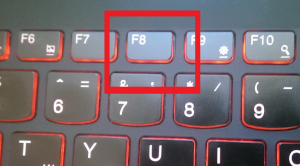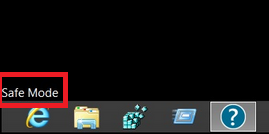| Name | SoftwareBundler:Win32/FakeDiX |
| Type | Downloader of Suspicious Software |
| Short Description | The program promises to download DirectX. |
| Symptoms | File changes and mutexes are observed. |
| Distribution Method | Unclear. The program may have been installed willingly or may have been brought by a bundled download. |
| Detection tool | Download SpyHunter, to See If Your System Has Been Affected By SoftwareBundler:Win32/FakeDiX |
SoftwareBundler:Win32/FakeDiX is a suspicious application that compromises the PC’s safety and performance. SoftwareBundler:Win32/FakeDiX is presented as a tool that downloads DirectX. However, it doesn’t. Instead, it creates suspicious .dll files on the system and injects malicious code to prevent detection. DirectX is a collection of application programming interfaces (APIs) for handling multimedia tasks on Microsoft platforms. Such tasks may be game and video-related.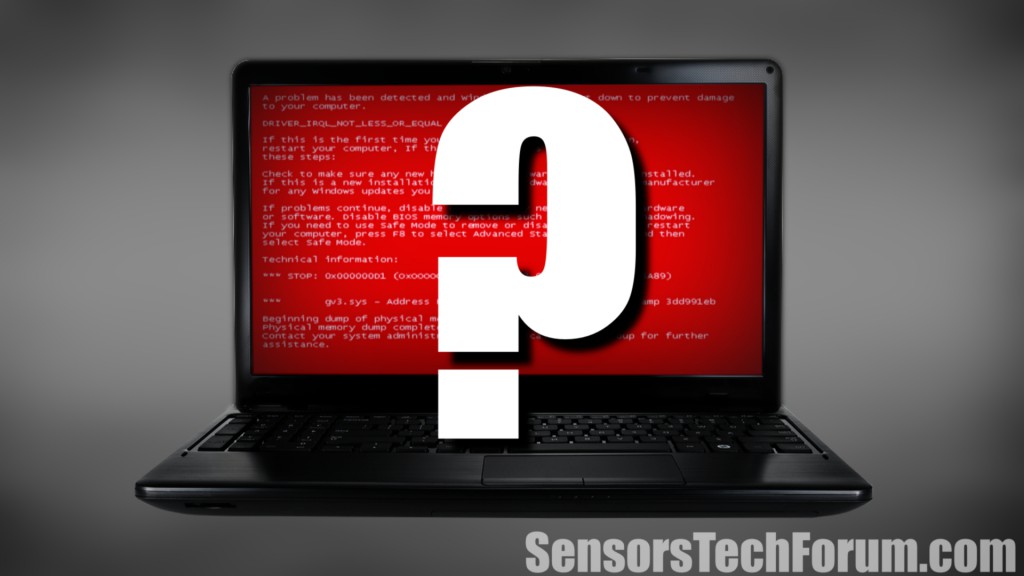
SoftwareBundler:Win32/FakeDiX Technical Description
As we already mentioned, the SoftwareBundler claims to download DirectX but it only jeopardizes the system. As reported by Microsoft, once installed, the suspicious application may create the following files:
- %TEMP%\is-u2id6.tmp\_isetup\_shfoldr.dll
- %TEMP%\is-u2id6.tmp\idp.dll
Furthermore, code injection may be employed by the malware piece to prevent detection and removal via anti-malware software. SoftwareBundler may also inject code into running processes.
What Is Code Injection?
Code injection is described as the exploitation of a PC bud, caused by processing invalid data. Hence, code injection is employed by cyber criminals to insert malicious code into a compromised program and alter the course of execution. Techniques of code injection are favored among hacking teams. Such tactics are used to hack or crack systems and obtain information, privilege escalation or unauthorized access. Code injection can be deployed for any of the following purposes:
- To modify values in a database through SQL injection.
- To install malware or execute malicious code on a server.
- To perform privilege escalation to root permissions.
- To attack users via HTML/Script injection also known as cross-site scripting.
SoftwareBundler:Win32/FakeDiX Payload Description
According to Microsoft researchers, the threat can connect to a remote host and:
- Search for an Internet connection.
- Download and run suspicious files and updates.
- Receive data.
- Receive malicious instructions.
- Upload data from the infected PC.
- Validate a digital certificate.
- Download malware.
In the case of SoftwareBundler:Win32/FakeDiX, BrowserModifier:Win32/SupTab can be downloaded onto the PC.
The SoftwareBundler is also observed to create mutexes on the system such as:
→RstrMgr3887CAB8-533F-4C85-B0DC-3E5639F8D511
→RstrMgr-3887CAB8-533F-4C85-B0DC-3E5639F8D511-Session0000
If you locate any of those on your computer, you should proceed towards cleaning it. Malware may have been downloaded.
SoftwareBundler:Win32/FakeDiX Removal Instructions
Since it is not clear what exactly may have been installed onto your system, it is highly advisory to use professional assistance, especially if you are a non-expert user. Also, remember that SoftwareBundler:Win32/FakeDiX can employ code injection. Since the program is observed to install multiple PUPs at the same time, all PUP pieces will have to be removed so that safety is restored. That is why it is recommended to start the removal process with an anti-malware scan. Then, experienced users may try and follow the instructions below the article.
1. Start Your PC in Safe Mode to Remove SoftwareBundler:Win32/FakeDiX.
For Windows XP, Vista, 7 systems:
1. Remove all CDs and DVDs, and then Restart your PC from the “Start” menu.
2. Select one of the two options provided below:
– For PCs with a single operating system: Press “F8” repeatedly after the first boot screen shows up during the restart of your computer. In case the Windows logo appears on the screen, you have to repeat the same task again.
– For PCs with multiple operating systems: Тhe arrow keys will help you select the operating system you prefer to start in Safe Mode. Press “F8” just as described for a single operating system.
3. As the “Advanced Boot Options” screen appears, select the Safe Mode option you want using the arrow keys. As you make your selection, press “Enter“.
4. Log on to your computer using your administrator account
While your computer is in Safe Mode, the words “Safe Mode” will appear in all four corners of your screen.
For Windows 8, 8.1 and 10 systems:
Step 1: Open the Start Menu
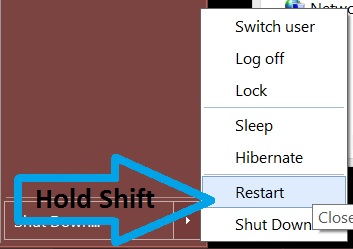
Step 2: Whilst holding down Shift button, click on Power and then click on Restart.
Step 3: After reboot, the aftermentioned menu will appear. From there you should choose Troubleshoot.
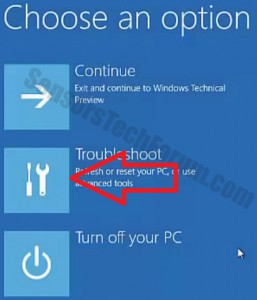
Step 4: You will see the Troubleshoot menu. From this menu you can choose Advanced Options.

Step 5: After the Advanced Options menu appears, click on Startup Settings.
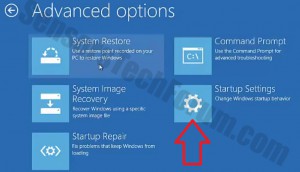
Step 6: Click on Restart.
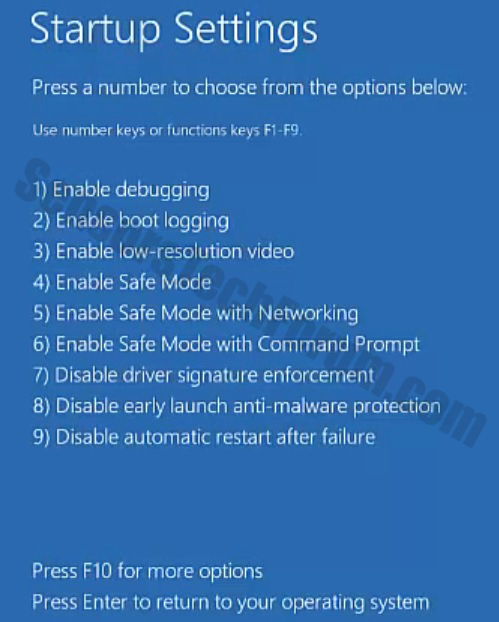
Step 7: A menu will appear upon reboot. You should choose Safe Mode by pressing its corresponding number and the machine will restart.
2. Remove SoftwareBundler:Win32/FakeDiX automatically by downloading an advanced anti-malware program.
Spy Hunter scanner will only detect the threat. If you want the threat to be automatically removed, you need to purchase the full version of the anti-malware tool.Find Out More About SpyHunter Anti-Malware Tool / How to Uninstall SpyHunter
To clean your computer you must download an updated anti-malware program on a safe PC and then install it on the affected computer in offline mode. After that you should boot into safe mode and scan your computer to remove all SoftwareBundler:Win32/FakeDiX associated objects.
Preparation before removing SoftwareBundler:Win32/FakeDiX.
Before starting the actual removal process, we recommend that you do the following preparation steps.
- Make sure you have these instructions always open and in front of your eyes.
- Do a backup of all of your files, even if they could be damaged. You should back up your data with a cloud backup solution and insure your files against any type of loss, even from the most severe threats.
- Be patient as this could take a while.
- Scan for Malware
- Fix Registries
- Remove Virus Files
Step 1: Scan for SoftwareBundler:Win32/FakeDiX with SpyHunter Anti-Malware Tool



Step 2: Clean any registries, created by SoftwareBundler:Win32/FakeDiX on your computer.
The usually targeted registries of Windows machines are the following:
- HKEY_LOCAL_MACHINE\Software\Microsoft\Windows\CurrentVersion\Run
- HKEY_CURRENT_USER\Software\Microsoft\Windows\CurrentVersion\Run
- HKEY_LOCAL_MACHINE\Software\Microsoft\Windows\CurrentVersion\RunOnce
- HKEY_CURRENT_USER\Software\Microsoft\Windows\CurrentVersion\RunOnce
You can access them by opening the Windows registry editor and deleting any values, created by SoftwareBundler:Win32/FakeDiX there. This can happen by following the steps underneath:


 Tip: To find a virus-created value, you can right-click on it and click "Modify" to see which file it is set to run. If this is the virus file location, remove the value.
Tip: To find a virus-created value, you can right-click on it and click "Modify" to see which file it is set to run. If this is the virus file location, remove the value.Step 3: Find virus files created by SoftwareBundler:Win32/FakeDiX on your PC.
1.For Windows 8, 8.1 and 10.
For Newer Windows Operating Systems
1: On your keyboard press + R and write explorer.exe in the Run text box and then click on the Ok button.

2: Click on your PC from the quick access bar. This is usually an icon with a monitor and its name is either “My Computer”, “My PC” or “This PC” or whatever you have named it.

3: Navigate to the search box in the top-right of your PC's screen and type “fileextension:” and after which type the file extension. If you are looking for malicious executables, an example may be "fileextension:exe". After doing that, leave a space and type the file name you believe the malware has created. Here is how it may appear if your file has been found:

N.B. We recommend to wait for the green loading bar in the navigation box to fill up in case the PC is looking for the file and hasn't found it yet.
2.For Windows XP, Vista, and 7.
For Older Windows Operating Systems
In older Windows OS's the conventional approach should be the effective one:
1: Click on the Start Menu icon (usually on your bottom-left) and then choose the Search preference.

2: After the search window appears, choose More Advanced Options from the search assistant box. Another way is by clicking on All Files and Folders.

3: After that type the name of the file you are looking for and click on the Search button. This might take some time after which results will appear. If you have found the malicious file, you may copy or open its location by right-clicking on it.
Now you should be able to discover any file on Windows as long as it is on your hard drive and is not concealed via special software.
SoftwareBundler:Win32/FakeDiX FAQ
What Does SoftwareBundler:Win32/FakeDiX Trojan Do?
The SoftwareBundler:Win32/FakeDiX Trojan is a malicious computer program designed to disrupt, damage, or gain unauthorized access to a computer system.
It can be used to steal sensitive data, gain control over a system, or launch other malicious activities.
Can Trojans Steal Passwords?
Yes, Trojans, like SoftwareBundler:Win32/FakeDiX, can steal passwords. These malicious programs are designed to gain access to a user's computer, spy on victims and steal sensitive information such as banking details and passwords.
Can SoftwareBundler:Win32/FakeDiX Trojan Hide Itself?
Yes, it can. A Trojan can use various techniques to mask itself, including rootkits, encryption, and obfuscation, to hide from security scanners and evade detection.
Can a Trojan be Removed by Factory Reset?
Yes, a Trojan can be removed by factory resetting your device. This is because it will restore the device to its original state, eliminating any malicious software that may have been installed. Bear in mind, that there are more sophisticated Trojans, that leave backdoors and reinfect even after factory reset.
Can SoftwareBundler:Win32/FakeDiX Trojan Infect WiFi?
Yes, it is possible for a Trojan to infect WiFi networks. When a user connects to the infected network, the Trojan can spread to other connected devices and can access sensitive information on the network.
Can Trojans Be Deleted?
Yes, Trojans can be deleted. This is typically done by running a powerful anti-virus or anti-malware program that is designed to detect and remove malicious files. In some cases, manual deletion of the Trojan may also be necessary.
Can Trojans Steal Files?
Yes, Trojans can steal files if they are installed on a computer. This is done by allowing the malware author or user to gain access to the computer and then steal the files stored on it.
Which Anti-Malware Can Remove Trojans?
Anti-malware programs such as SpyHunter are capable of scanning for and removing Trojans from your computer. It is important to keep your anti-malware up to date and regularly scan your system for any malicious software.
Can Trojans Infect USB?
Yes, Trojans can infect USB devices. USB Trojans typically spread through malicious files downloaded from the internet or shared via email, allowing the hacker to gain access to a user's confidential data.
About the SoftwareBundler:Win32/FakeDiX Research
The content we publish on SensorsTechForum.com, this SoftwareBundler:Win32/FakeDiX how-to removal guide included, is the outcome of extensive research, hard work and our team’s devotion to help you remove the specific trojan problem.
How did we conduct the research on SoftwareBundler:Win32/FakeDiX?
Please note that our research is based on an independent investigation. We are in contact with independent security researchers, thanks to which we receive daily updates on the latest malware definitions, including the various types of trojans (backdoor, downloader, infostealer, ransom, etc.)
Furthermore, the research behind the SoftwareBundler:Win32/FakeDiX threat is backed with VirusTotal.
To better understand the threat posed by trojans, please refer to the following articles which provide knowledgeable details.













